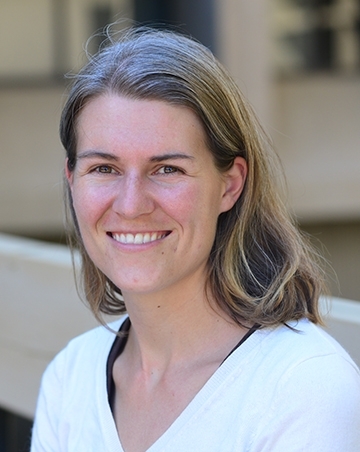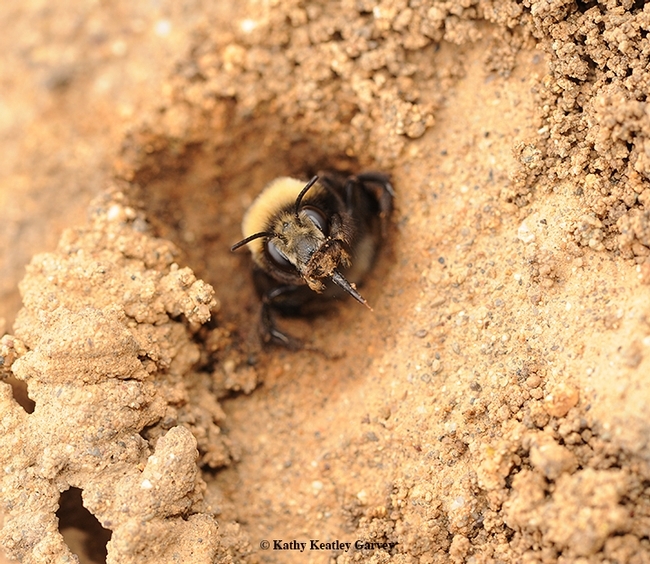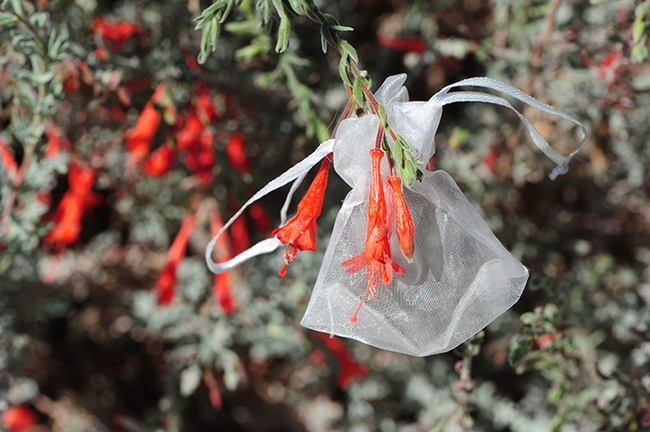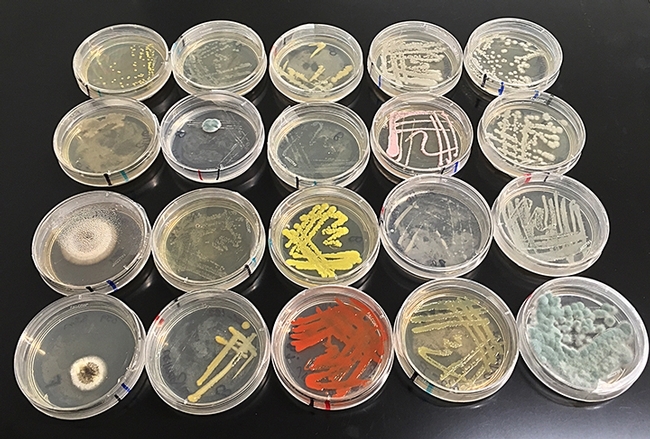- Author: Kathy Keatley Garvey

Vannette, an assistant professor, seeks to unlock the mysteries of flower microbes: how do plants protect against them, and can bees benefit from them?
“I am interested in understanding and predicting how microbial communities influence interactions between plants and insects,” she says. Her lab uses "tools and concepts from microbial ecology, chemical ecology, and community ecology to better understand the ecology and evolution of interactions among plants, microbes and insects."
Vannette recently received a five-year Faculty Early Career Development (CAREER) Program award, titled “Nectar Chemistry and Ecological and Evolutionary Tradeoffs in Plant Adaptation to Microbes and Pollinators. NSF grants CAREER awards to early career faculty “who have the potential to serve as academic role models in research and education and to lead advances in the mission of their department or organization,” a NSF spokesman said.
The other grant is a three-year grant, “The Brood Cell Microbiome of Solitary Bees: Origin, Diversity, Function, and Vulnerability.” Vannette serves as a co-principal investigator with professor Bryan Danforth, Cornell University; research entomologist Shawn Steffan of the USDA's Agricultural and Research Service, University of Wisconsin; and assistant professor Quinn McFrederick, UC Riverside.
Of the CAREER grant, Vannette explained in her abstract:
“Plants interact with a variety of organisms. The flowers and the nectar plants produce are adapted to attract beneficial organisms like bees or hummingbirds. However, microbes like bacteria and fungi also inhabit flowers and can reduce plant reproduction. Plant traits can reduce microbial growth in nectar, but this may also reduce pollinator visitation. This project will investigate if plants that are pollinated by different organisms (e.g. birds vs bees vs flies) differ in their ability to reduce microbial growth and if nectar chemistry is associated with microbial growth. This project will examine if nectar traits can be used to breed plants to be more resistant to harmful microbes without reducing attraction to pollinators. Resistance to microbes is beneficial in agricultural contexts where floral pathogens can limit food production but crops still rely on pollination.
“This research will link variation in plant phenotype to microbial abundance and species composition, and microbial effects on plant-animal interactions,” she noted. “This project will use a tractable system: the microorganisms growing in floral nectar, which can influence floral visitors and plant reproduction. The underlying hypothesis tested is that plant traits can facilitate or reduce microbial growth, and the community context (e.g., presence of pollinators) influence ecological and evolutionary outcomes.”
Vannette will perform the research activities using 1) a community of co-flowering plant species and 2) genotypes within California fuchsia (Epilobium canum). “Experiments will characterize variation in microbial growth, nectar chemistry, and microbial effects on plant reproduction and floral visitor behavior and the interactions of these factors,” she related in her abstract. “ Experiments and analysis will reveal how variation in nectar chemistry is associated with microbial growth and species composition in nectar, and subsequent effects on plant-pollinator interactions including plant reproduction. Experiments across Epilobium genotypes will elucidate how microbes affect microevolution of floral traits in a community context.”
The project “will engage students from a large undergraduate class to participate in practitioner-motivated research projects,” she wrote. “Students from the Animal Biology major, including in the class ABI 50A will participate in outreach on pollinator-friendly plantings for horticultural and landscaping. The project will support students recruited from diverse and underrepresented backgrounds to participate in independent projects related to project objectives, including hosting students through the Evolution and Ecology Graduate Admissions Pathway (EEGAP), a UC-HCBU program." The program connects faculty and undergraduate scholars at both UC (University of California) and HBCU (Historically Black Colleges and Universities) campuses
Collaborative Grant
The collaborative grant will enable the researchers to do cutting-edge research as they investigate the diverse community of bacteria and yeasts in the pollen and nectar diet of bees.
“Bees are the single most important pollinators of flowering plants worldwide,” the co-investigators wrote in their abstract. “Over 85% of the 325,000 flowering plant species on earth depend on animals for pollination, and the vast majority of pollination is carried out by bees. Annually, bees are estimated to contribute $15 billion to US crop production and $170 billion to global crop production. High-value bee-pollinated crops include apple and other early spring tree fruits, strawberries, blueberries, cherries, cranberries, squash and pumpkins, tomatoes, almonds, and many others. The economic viability of US agricultural production is dependent on stable and healthy wild and domesticated bee populations.”
“However, bee populations are threatened by a variety of factors, including habitat loss, pathogen spillover, invasive plants and animals, and pesticide use, which can disrupt the normal microbial symbionts essential for bee larval development (the ‘brood cell' microbiome),” they pointed out in their abstract. “This research project focuses on understanding what role microbes play in the larval nutrition in a wide variety of bee species. Previous research has documented a diverse community of bacteria and yeasts in the pollen and nectar diet of bees. As larvae consume these pollen/nectar provisions they are ingesting microbes, and our preliminary results indicate that these microbes form an essential component of the larval diet. This project has the potential to significantly modify how we view the 120 million-year-old partnership between bees and flowering plants, and will provide essential information for developing long-term bee conservation efforts. Project outreach efforts include educational activities on solitary bees for K-12 students and interactive demonstrations of bee-microbe-flower interactions for broad audiences.
The co-principal investigators said that the project will use cutting-edge methods to (1) document the microbial diversity in flowers and pollen provisions, (2) determine the nutritional role of microbes in larval development and health, and (3) understand how alterations in microbial community impact larval development.
To document microbial diversity in both host-plant flowers and pollen provisions, the research team will use amplicon sequencing and microbial metagenomics. These methods will document the microbial species present in pollen provisions as well as the metabolic activities these microbes perform during pollen maturation. Screening the pollen and nectar of host-plant species will provide key insights into the source of the brood cell microbiome. To determine the nutritional role of the microbial community the research team will use two methods from trophic ecology: compound specific isotope analysis and neutral lipid fatty acid analysis. These analyses will permit the research team to track the origin (floral or microbial) of amino acids and fatty acids in the larval diet of 15 focal bee species.
Finally, through manipulative laboratory experiments, the research team will determine how modifications of the microbial communities impact larval development. They hope by combining the results of these studies, the researchers will provide a comprehensive understanding of how bees and flowering plants interact via their shared microbial partners.
The collaborative project is funded jointly by the Systematics and Biodiversity Sciences Cluster (Division of Environmental Biology) and the Symbiosis, Defense and Self-recognition Program (Division of Integrative Organismal Systems).
Vannette, a Hellman Fellow, joined the UC Davis Department of Entomology and Nematology in 2015 after serving as a postdoctoral fellow at Stanford University's biology department. As a Gordon and Betty Moore Foundation Postdoctoral Fellow from 2011 to 2015, she examined the role of nectar chemistry in community assembly of yeasts and plant-pollinator interactions.
A native of Hudsonville, Mich., Vannette received her doctorate in ecology and evolutionary biology from the University of Michigan, in 2011. Her dissertation was entitled “Whose Phenotype Is It Anyway? The Complex Role of Species Interactions and Resource Availability in Determining the Expression of Plant Defense Phenotype and Community Consequences.”





